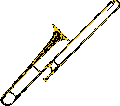


The modern orchestra also contains trombones and tubas, and sometimes the cornet, the euphonium, the flugelhorn, the alphorn, the ophicleide and the giant Sousaphone – named after the American composer of marches.
Brass players control their instruments by means of valves, and have to master 'embouchure' – the technique of using the mouth muscles to create notes of different pitch.
TRUMPET
The trumpet tunes of 17th and 18th Century England, particularly those of Jeremiah Clarke, Henry Purcell and Handel, capture the military and ceremonial character of the instrument. Its bright clarion sound gave it solo status in music of the baroque, and later its spectacular fanfares have been widely used. The music of Berlioz, Verdi and Britten has splendid examples of trumpet choirs in full cry.
HORN
The horn joined classical and baroque orchestras, either as a solo instrument or in matching pairs, and brought the tarantara of the chase with it. Today's orchestra employs up to eight horn players for the grat symphonies of Bruckner and Mahler; but even Haydn , in his oratorio The Seasons, asked for six in the hunting scene. To play, it is one of the most unpredictable if magnificent of brass instruments.
TROMBONE
 Unique among brass instruments for their distinctive slide, trombones have hardly changed in their basic design since the middle of the 15th Century, when they were called sackbuts. The brass instruments of military and brass bands, their resounding tone is associated with silemn ceremony. I early opera, they are linked with the appearance of the Gods of Olympus, the Sea and the Underworld.
Unique among brass instruments for their distinctive slide, trombones have hardly changed in their basic design since the middle of the 15th Century, when they were called sackbuts. The brass instruments of military and brass bands, their resounding tone is associated with silemn ceremony. I early opera, they are linked with the appearance of the Gods of Olympus, the Sea and the Underworld.
The trombone pitches notes by lengthening the air column blowing through the fixed and moving parts of the tube. The slide positions only give the player a limited number of options, so like all brass-players the trombonist must create notes by moulding the muscles of his mouth to the cup of the mouthpiece.
EUPHONIUM
This little brother of the tuba belongs to the brass band rather than the orchestra. The euphonium plays in the tenor and bass ranges and finds its way in to the concert hall by playing the tenor tuba parts of orchestrial works such as Stravinsky's Rite of Spring and Holst's Planets Suite.
TUBA
Oddly, tuba is the Latin for trumpet, but nothing could be more different from the brilliance of that instrument than the fat, unwieldy bass of the brass section, whose low notes rumble and rasp in the bottom-depths of the orchestra. The instrument's weight, and the size of its mouthpiece, call for a player of exceptional stamina – and a lot of patience, too, since the tuba is given very few of the best tunes!
